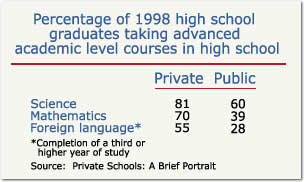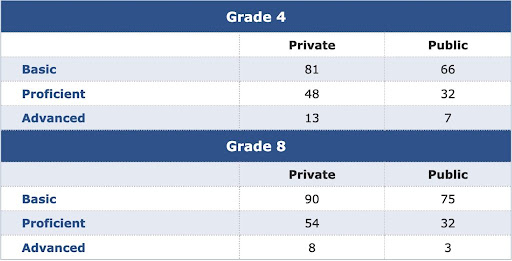Academic Excellence
Teachers expect excellence from students, and students tend to live up to those expectations. The high expectations and academic rigor help account for above-average levels of student success, including higher college-going rates. If you’re looking to help your child reach his/her potential in a school committed to excellence, consider a private school.
The high expectations and academic rigor help account for above-average levels of student success, including higher college-going rates. This is particularly true for students from families with lower “socio-economic status” (SES).
If you’re looking to help your child reach his/her potential in a school committed to excellence, consider a private school. Please read below for a deep dive into some stats reported by the U.S. Department of Education (USDE) and the National Center for Educational Statistics (NCES).
The Stats and Data from U.S. Department of Education
In a report titled Private Schools: A Brief Portrait, the U.S. Department of Education had this to say about the academic performance of private schools:
- Private school students generally perform higher than their public school counterparts on standardized achievement tests.
- Private high schools typically have more demanding graduation requirements than do public high schools.
- Private school graduates are more likely than their peers from public schools to have completed advanced-level courses in three academic subject areas (see table).
- Private school students are more likely than public school students to complete a bachelor’s or advanced degree by their mid-20s (see table).
Private school students scored well above the national average in the National Assessment of Educational Progress (NAEP). NAEP scores provide an immediate measure of student achievement, but the report also presents a long-term measure: attainment of a college degree. “[S]tudents who had attended private school in 8th grade were twice as likely as those who had attended public school to have completed a bachelor’s or higher degree by their mid-20s (52 versus 26 percent).”

And note this: For students from the lowest quartile of socioeconomic status (SES), the advantage of having attended a private school was even more pronounced. Those students were nearly four times more likely than their public school counterparts to have attained a bachelor’s or higher degree (table 6). Private school attendance even seems to overcome a parent’s low-expectations for a child. “[F]or students whose mother’s expectation (in 8th grade) was for them to attain an associate’s degree or less, those who had attended private school completed a bachelor’s or higher degree at a rate about four times that of public school students (30 versus 7 percent).”
The report explains that students from a low SES family who had “completed a calculus course in high school were much more likely than those who had not studied calculus to earn a degree by their mid-20s.” It also notes that students in private schools “are more likely than those in public schools to take challenging courses like calculus, and private schools are more likely to require them.” Specifically, private high schools require more courses for graduation than public high schools in math, science, social studies, foreign language, and computer science, and the coursework is more likely to include advanced courses in science (chemistry, physic, advanced biology), mathematics (trigonometry, precalculus, calculus), and foreign language (a third year or more).

Demanding coursework and high expectations are good for students. As the report states it, “Applying high academic standards–both requiring students to complete high-level, challenging courses and pushing students to strive and excel in their work–is a central schooling component that many experts recommend.”
High Achievement
According to National Center for Educational Statistics (NCES) data, 88 percent of private high school students apply to college, compared to 57 percent of public high school students. And reports from the College Board indicate that SAT scores for private school students are well above the national average.
When it comes to challenging students to stretch their capacity, private schools do an exceptional job. Statistics from the College Board and NCES show that for high school seniors, 24.2 percent of private school students took AP exams in 1998, while 9.4 percent of public school students did so. Private schools, which account for only 7.5 percent of all high school students, produced 20 percent of 12th graders who took AP exams in 1998 and 22 percent of those who scored high enough to have the advanced courses count for college credit.
NAEP Results
Review more data about NAEP results >
The NCES periodically administers the National Assessment of Educational Progress (NAEP) to test the knowledge and skills of the nation’s students in grades 4, 8, and 12. Students in private schools consistently score well above the national average. At all three grades a significantly higher percentage of private school students score at or above the Basic, Proficient, and Advanced levels than public school students. Below are the results from the most recent NAEP report cards in reading. NAEP report cards in other subjects.
NAEP 2011 Reading Report Card
Percentage of Students in Public and Private Schools At or Above Various Achievement Levels

Browse More Literature
Learn More about academic performance at private schools

